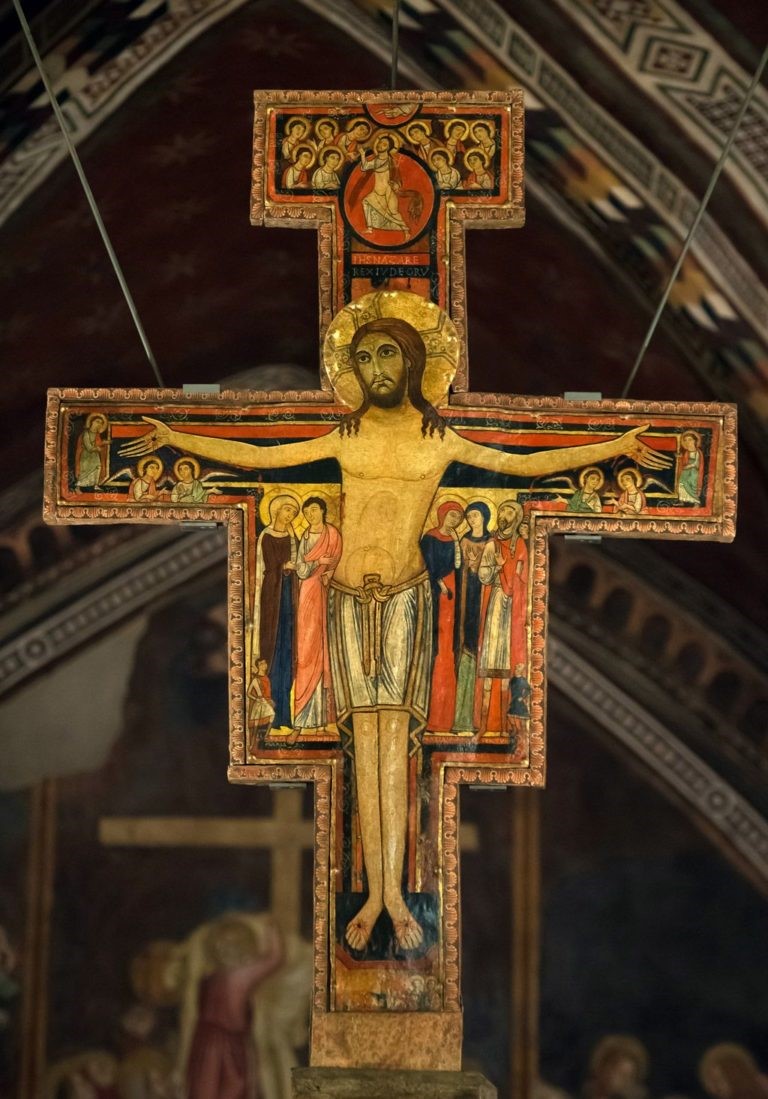Seven Last Words: 3. Woman, behold your son. Son, behold your mother (John 19:26-27)
When Jesus saw his mother and the disciple whom he loved standing beside her, he said to his mother, ‘Woman, here is your son.’ Then he said to the disciple, ‘Here is your mother.’ And from that hour the disciple took her into his own home.
The San Damiano crucifix is a busy sort of cross. Unlike those of the later centuries, presenting only Jesus’ suffering body more or less realistically, that crucifix at Assisi is a flat cross-shaped painting, depicting a veritable crowd. There are figures beside and around Jesus, down the length and along the arms of the cross. Angels and apostles squeeze their ways into the gaps beside and beneath him. It is a crucifix that depicts not just Jesus, but the human world he is remaking, a world of renewed relationships, a community.
Like so many others, this cross gives prominence to the recipients of this third creative word from the cross, that is, to Mother of Jesus and the disciple whom Jesus loved, to give those whom we know as Mary and John their designations from John’s Gospel, standing next to Jesus. When Francis heard the San Damiano crucifix speaking to him and instructing him, the words echoed this more ancient word from the first cross and those to whom it was delivered, depicted on the one in front of him.
“Woman, behold your son. Son, behold your mother” is a breathtakingly simple creation of relationship. With this third word of his new creation from the Cross, Jesus makes a family of two who loved him as much as any ever have, but were not otherwise bound to each other before. In acting thus he effectively founds the Church, a community of love based on love of him.
Jesus’ creative work on the cross is not only that of offering forgiveness and the hope of Paradise; it is also the work of restoring us as human beings to one other. Sin - the human experience of brokenness and failure - is not only a matter of our distance from God, but of our mutual alienation.
A work of salvation that seemed to remedy our individual needs for forgiveness and healing would be meaningless, were it not to extend to healing the brokenness of human community. All those today going about their business outside in this city, however little explicit sense of God or of awareness of the spiritual character of the human malaise they may have, would be hard pressed to deny the reality of our humanity itself being broken.
Each generation, each year, seems to have its distinctive ways of being inhuman; take your pick today between racism and terrorism, insurgencies far away and surging inequality close to home, or just consider our squabbles over which of our inhumanities is really worse, and which remedy for it the least vile.
But we need not look to the easy pickings of politics to ponder the scope of human brokenness. In the realities of our own everyday lives, we discover again and again how hard it is simply to be loving, how hard merely to be kind; so even in our families, our friendships, our Churches, we experience - and cause - brokenness in relationship, and we may feel angry and alone, and cause others to feel so too.
In the narrative of Genesis, where the origins of the world and humankind are narrated theologically through the collective mythic memory of Israel, we often speak of a single “fall,” when Adam and Eve are expelled from the Garden of Eden. In fact there are multiple falls across that primeval narrative, away from each other as well as from God; Cain's and Abel's violent sundering of brotherhood, the Tower of Babel’s story of humanity scattered into fragmentary parts of mutual incomprehension, are as much signs of the human condition as our original failure to stay in relationship with God in Paradise.
In all those stories, humans are unable to love those to whom they were already bound by blood; but in this story, Jesus binds together those who had no such tie. Where once we struggled to love those who love us, Jesus suggests we can love others whom we had not known or understood, even our enemies; and more to the point, he creates that love in the speaking of it.
If we dare follow him as far as the cross, we can expect him to speak to us, as to Mary and John, as to Francis. We can expect him to make us mothers and sons to people we did not expect, and probably did not want. Jesus will not exempt the refugee and the migrant from his care and our responsibility in the name of our own security, for instance. Nor will he exempt those closest at hand whom we have found ourselves unable to remain in relationship with because we cannot understand or do not like their opinions or values or identity.
He speaks still from the cross, and we hear not only his binding together of Mary and John but of ourselves, to each other and to him. Rebuild my Church; rebuild my world. Here now today, and as we go out into the streets of the city, he says again and again “here"; “here is your father,” “here is your daughter,” “brother," “sister,” “son,” “mother.”



Comments
Post a Comment